[Jennifer admires the thoughtful, measured effort that went into the creation and curation of Traction Company’s new exhibit. The show occupies itself with ideas of construction, space, and community. — the artblog editors]
Traction Company’s “Truss” (2015), on view at the Pennsylvania Academy of the Fine Arts (PAFA), is an unexpected but heroic art object. “Truss” is a full-scale replica of a timber roof support from the Traction building, a former trolley-manufacturing warehouse now serving as studio space for Traction’s collective of 12 artists, all PAFA alumni. It is 65 feet long and constructed of immense wood beams, which were purchased by the group from a nearby demolition site of a same-era building in the quickly-gentrifying West Philadelphia neighborhood.
“Truss” was was made to stand on the same museum floor that we walk on, and we can see every element: the bolts, washers, and nuts, the weighty girders, the intricate, trustworthy joints. This truss was built by hand according to 19th-century traditions. It is gigantic. Standing next to it, we can imagine the massiveness of the Traction warehouse and begin to appreciate Traction Company’s investments of time and handcraft. An ode to the past, “Truss” makes manifest the spirit of recycling and a “can-do” attitude. But this sturdy mammoth may also belie the group’s anxiety about the fate of their glorious wreck of a building, which may in the future fall prey to a developer’s deal.
Perched between past and future
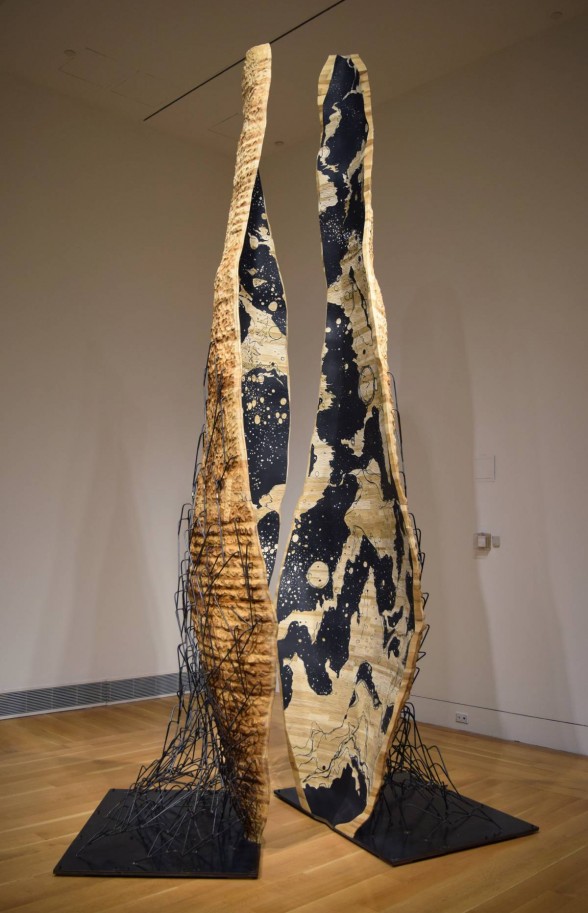
Like “Truss,” other works in this exhibition tell us something about Traction’s building and what happens there. Jeffrey Dentz’s woodcut prints on Japanese paper show the structure in its West Philadelphia setting. “Passage” (2015) illustrates the whole of the warehouse as a duality–the left side is a detailed, oblique view of the building, the right side is a ghostly, flat shape. This print visually summarizes what Traction member Miguel Horn described to me: The building is an intact example from the old world, a holdout of history, but somewhat threatened by an unseeable future of encroaching gentrification, ensuing rent increases, or possible sale.
“subTraction” (2013) is a miniaturized replica of the entire building, complete with so many minute workbenches, power tools, saws, and in-process sculptures. Supporting the roof of “subTraction” are eight small trusses, mini versions of the monumental “Truss” elsewhere in the gallery. Inside “subTraction,” we are giants. From our vantage point, we oversee the processes dedicated to traditional sculpture methods and the results of collaborative spirit. This is a building where work happens, where we can see how one truss can be symbolic of this collective–an object made of individual members, who, when combined, are strong enough to hold up a roof.
“subTraction” was created as part of Philadelphia’s citywide festival of alternative galleries in 2013. It was an exchange piece with Napoleon Gallery, a tiny space at 319 N. 11th St. When installed at Napoleon, “subTraction” filled almost the entire gallery space. This spirit of exchange continues, as Napoleon was invited to contribute an installation here in the Traction Company exhibition at PAFA.
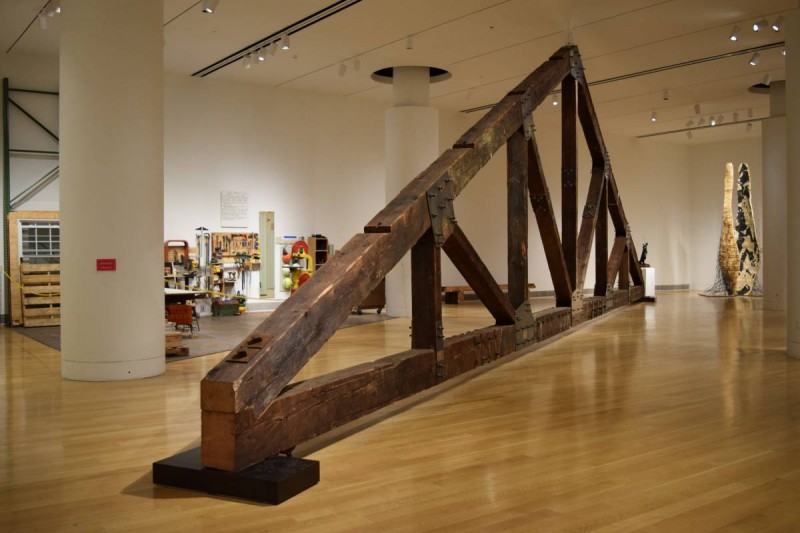
Classical influences
A significant portion of this exhibition is given over to examples of Modular Studios (2015), Traction Company’s practical solution for the uncertain future of their warehouse. These studios are built economically with off-the-shelf parts, and the result is a mobile building unit that can be single or grouped to accommodate work spaces or art galleries. It is conceivable that these pods could also be post-disaster shelters or a solution for housing shortages. Here in the exhibition, a two-story “Modular Studio” houses on its bottom floor the installation by Napoleon Gallery. Yet another unit is outfitted with egg-crate soundproofing to accommodate a screening of “Dinner @ Traction” (2015), a video work by Sedakial Gebremedhin. In the short film, we see the hard, industrial Traction building softened by the addition of green grass turf and set for an Ethiopian meal shared by two elegant people: Gebremedhin and a female friend.
The two people in “Dinner @ Traction” relate slowly and deliberately over a shared meal. They feed each other and take the time to look in each other’s eyes. This exhibition overall invites deliberate, long looking. Thoughtful attention to craft is made apparent everywhere, including in the exhibition wall labels, which are all neatly hand-lettered. With all that is fleeting and instant in our contemporary world, noticing labels like these, or considering a bronze sculpture with heroic themes, “may be more relevant than we think,” as Miguel Horn suggested when I asked him about the importance of bronze today. Horn noted that Traction Company has the means for creating everything around the bronze process–pattern-making, wax casting–but it does not have a foundry. The sculptural traditions in which the Traction artists were educated can easily be experienced firsthand by visiting PAFA’s second-floor sculpture study room.
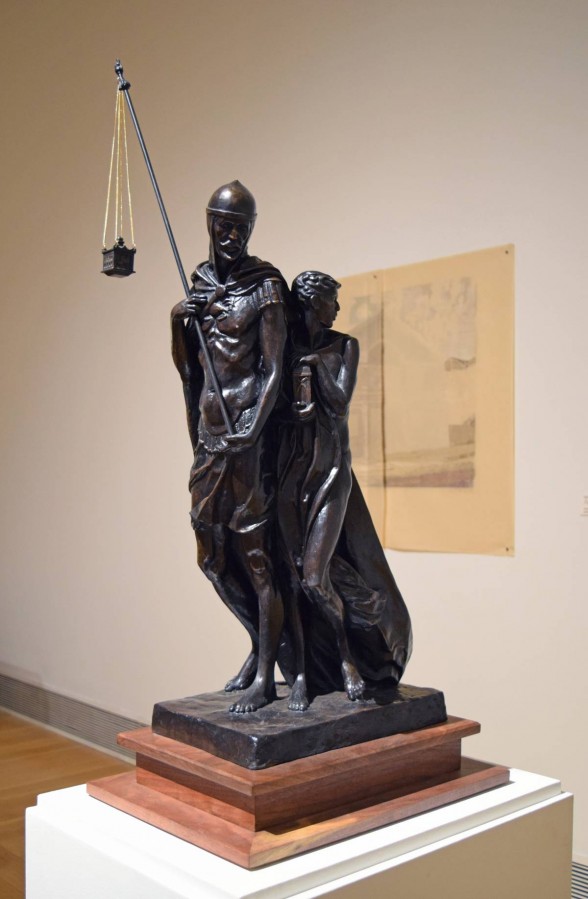
Joshua Koffman’s “Synagoga & Ecclesia” (2015) is a white plaster version of a future bronze to be installed at St. Joseph University’s Institute of Catholic-Jewish Relations. It will be dedicated this fall in conjunction with the Pope’s visit to Philadelphia. The sculpture elegantly re-dresses centuries of anti-Semitic imagery, which showed Synagoga defeated and blind. Koffman has made his figures equals; their poses mirror one another, and they are physically connected by flowing, classic drapery.
Other bronze works, such as Connie Ambridge’s “Joan of Ark” [sic] (2015) and Morgan Dummitt’s “Wayfarers” (2015), feature heroic, helmeted figures from a past era. Ambridge’s “Joan” has a soft elegance despite her top-heavy armor helmet. The materials dazzle: The artist fashioned a golden brass-colored, jewelry-like chain mail over the figure’s dark bronze neck and shoulders. These noble themes and concentration on craft would delight any 19th-century Arts and Crafts practitioner. But rather than rehashing the past, these bronzes substantiate the robust presence of representational sculpture within contemporary art.
Grounded in hard work
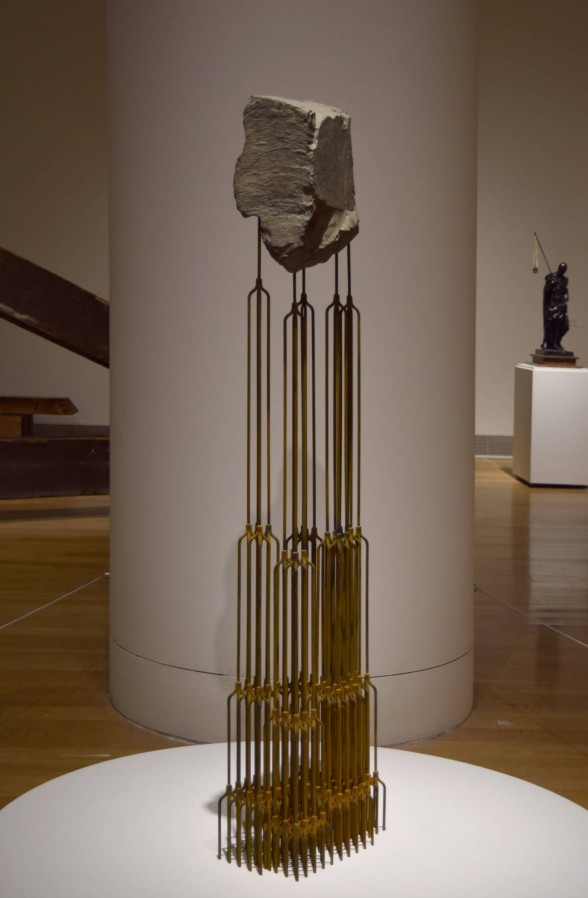
There is so much in this exhibition–drawings, prints, videos, photographs, sculptures, written plans, archives, embroideries, architectural re-creations. It would all overwhelm if not for the consistently attention-grabbing construction and materials of so many objects here. Take “Wissahickon Scholar Stone” (2015) by John Greig, a combination of a hefty, natural chunk of shale set atop delicate, elongated steel supports. The support base includes many steel beams strengthened by multiple arches, but this sturdy foundation becomes precarious as it tapers upwards into single steel rods that penetrate the stone and hold it aloft. Which part of this is more remarkable: the human engineering or the natural stone, which, with its deep, shadowy pockets and brightly lit plateaus, resembles a vast landscape?
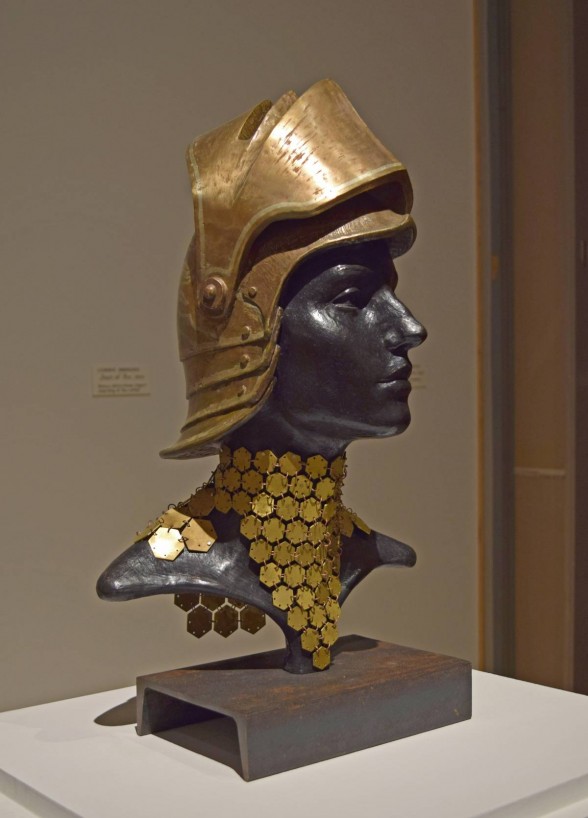
Any lofty focus on the sculptures in this exhibition is soon brought back to earth by practical reminders of hard work. As we enter and leave the Traction Company exhibition, we pass a life-size, walk-in shed. This structure is another stand-in for the Traction building itself. Inside we become an artist in the collective, here to change into or out of protective, warm work clothes and shoes. Here are the Carhartt-style coveralls waiting on their hooks. Here are the work boots tidy in their cubbies. On the wall by the door is a first aid kit; here are the Band-Aids. If this shelter contains the concrete reminders of work and what it takes, then Laura Giannini’s “Mason Basin” (2015) provides the metaphor. “Mason Basin” is a bathtub constructed of countless small, red bricks. Submerging in this bath would mean that our bodies and our field of vision are enclosed by this ancient and ubiquitous building material: a body surrounded by brick walls, yet another small architecture. But this sculpture could have taken any shape at all, as the self-evident masonry suggests that this is more a meditation on work and progress than anything else. Giannini shows us that creating something–a building or a truss, an artist collective, or whatever it is that any of us may endeavor to make–happens bit by bit, brick by brick.
Traction Company is on view at the Pennsylvania Academy of the Fine Arts through Oct. 11, 2015.









